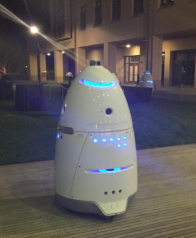According to RnRMarketResearch.com, the commercial airborne drones market is estimated at $609 million in 2014 and will reach over $4.8 Billion by 2021. There are several venture capital firms that have created specialized funds to fuel this growth such as the Commercial Drone Fund and DJIAccel’s Skyfund. These market projections are for Unmanned Aircraft Systems (UAS) and exclude drones by land and by sea. For practitioners in the electronic discovery and computer forensics fields, these drones represent enormous data sizes for discovery and analytics. Liquid Robotics makes a drone that stores nine terabytes of data per year. The drone (pictured right) is being sold as a more cost effective way to perform data security at rates as low as $6.25 per hour. The drone takes 360° pictures and may be used effectively in unsafe environments that security guards may find hazardous. Drones have had some bad press lately. One example was in June 2015 when firefighters were in-flight to a burning site to extinguish a fire in Southern California. They were immediately called off from continuing to their destination out of fear of a mid-air collision with a drone resulting in the fire growing. Beyond collision, there was fear that the drone may get into the propeller of a helicopter or an engine of an airplane and cause the aircraft to crash. Another example is in October 2015 when the U.S. Park Police confiscated a drone that crashed on the Ellipse near the White House on Friday and issued a citation to the operator involved. Despite the potential innocent intentions and prohibited drone use in Washington D.C., this incident sparked increased scrutiny of hobbyists flying drones and safety issues, especially in light of a DJI Phantom crashing in the grounds of the White House earlier in the year by a drunk operator. Some experts believe geofencing mechanisms may be built into drones to override the commands preventing the devices from flying into protected airspace (e.g. government buildings, sports stadiums, etc.). On the Internet of Things (IoT) spectrum, drones may not be mainstream yet, but there are many commercial implementations to evaluate for discovery purposes. Some select examples include:
- 1. A consumer purchases $5,000 of stereo equipment which is delivered to the door of her house by a drone. The consumer communicates they have never received the package. However, the drone maintains a scan of the recipient’s QR code and takes a picture of the recipient and her house as it flies away. This authentication invalidates the customer’s claim that they haven’t received the package. A QR code consists of black modules (square dots) arranged in a square grid on a white background, which can be read by an imaging device such as a scanner and used for validation purposes.
- 2. A major telecommunications company uses drones to perform periodic inspections of its cell towers. This enables the company to decrease their workers compensation insurance and increase the safety of its employees. It also enables them to better document the state and potential repair of their equipment through high quality images.
- 3. A nuclear plant has an explosion. Drones are used to aid the disaster relief team in gathering information to assess the situation and provide recommendations on how to direct resources minimizing harm to the incident response team. The images also enable investigators to determine the root cause for the explosion.
